|
Size: 5182
Comment:
|
← Revision 32 as of 2021-05-21 03:56:35 ⇥
Size: 13458
Comment:
|
| Deletions are marked like this. | Additions are marked like this. |
| Line 2: | Line 2: |
| MORE LATER | Thinsat radios will have multiple low-power outputs and communicate to many printed-circuit antennas and resonant impedance matching structures. They will talk on multiple bands, for downlink, uplink, femtosecond-precision array timing, micron-precision thinsat location and orientation within the array, and orientation to other arrays and to GPS and ground systems. Much of this accuracy will come from continuous monitoring and averaging, differential and quadrature analog signal processing, and the ultra-low vibration and perturbation environment of a thinsat in a completely predictable nano-gee space environment. MoreLater == Timing precision and synchronization == In the late 1990s, Keith Lofstrom worked with Teradyne and Analog Devices to produce a timing interpolator system for a tester that produced timing edges with 1ps resolution within a 2ns time period. Measurements showed that the timing accuracy of each edge from the interpolator chip was less than the 8 femtoseconds resolution of the measurement equipment. This was for single edges - an system that averages trillions of periodic edges into planar resonators should be able to estimate system phasing to fractions of a femtosecond; at the speed of light, this is a small fraction of a micron. To achieve this, the measurement system must be well isolated from all noise sources, and all signals must be differential, with balanced power on all edges, balanced grounds and power signals to each circuit, etc. Vibration can generate errors, but the vibrations will be very small in a thinsat (mostly related to transients caused by the LCD thrusters, and perhaps from nano-meteor impact) and measurable. Thermal variations will occur as various electronic sections turn on and off, but these thermal variations can be characterized and extracted. Perhaps the largest source of unpredictable perturbations will be radio energy from other arrays coupling with signal runs on the thinsat; this may require extra ground planes. MoreLater |
| Line 5: | Line 11: |
| As a new service, server sky will likely be allocated [[http://en.wikipedia.org/wiki/Extremely_high_frequency|EHF frequencies]] for the downlink - in the 30GHz to 300GHz range. For now, let's assume a frequency of 38GHz and a wavelength of 8 millimeters. This wavelength is smaller than the size of a thinsat, so directional beams can be made with thinsat scale antennas. Each thinsat can direct radio energy into an angle of perhaps sin^-1^(0.1) or 6 degrees, for a ground spot of perhaps 600km. | |
| Line 6: | Line 13: |
| As a new service, server sky will likely be allocated [[http://en.wikipedia.org/wiki/Extremely_high_frequency|EHF frequencies]] for the downlink - in the 30GHz to 300GHz range. For now, let's assume a frequency of 38GHz and a wavelength of 8 millimeters. This wavelength is smaller than the size of a server-sat, so directional beams can be made with server-sat scale antennas. Each server-sat can direct radio energy into an angle of perhaps sin^-1^(0.1) or 6 degrees, for a ground spot of perhaps 600km. | However, the directionality of thinsats comes from their ability to act as a phased array. Constructive and destructive interference between phase locked arrays of thinsats permits ground spots of a few tens of meters - better than cellular service and WIMAX. The wider the array, the smaller the ground spot, so for downlink at least, adding thinsats will improve spatial multiplexing bandwidth, with no practical limits on download bandwidth to billions of customers on earth. |
| Line 8: | Line 15: |
| However, the directionality of sever-sats comes from their ability to act as a phased array. Constructive and destructive interference between phase locked arrays of server-sats permits ground spots of a few tens of meters - better than cellular service and wimax. The wider the array, the smaller the ground spot, so for downlink at least, adding server-sats will improve spatial multiplexing bandwidth, with no practical limits on download bandwidth to billions of customers on earth. | A phased array works by adjusting the time delay of each thinsat transmitter so that the signals from each transmitter, located at a different distance from the receiver, all arrive at the receiver at same time. If each transmitter is emitting a pure sine wave, this can be accomplished by shifting the phase of the outgoing signal. |
| Line 10: | Line 17: |
| A phased array works by adjusting the time delay of each server-sat radio so that the signals from each radio, located at a different distance from the receiver, all arrive at the receiver at same time. If each transmitter is emitting a pure sine wave, this can be accomplished by shifting the phase of the outgoing signal. The easiest way to do this is to compute the path length from each transmitter to the ground receiver in wavelengths, take the fractional part, and conjugate it (that is, the negative fractional part becomes the phase of that transmitter). For a 10000km path, that can be accurately represented as a 30.10 bit fixed point number or a 64 bit IEEE754 floating point number. |
The easiest way to do this is to compute the path length from each transmitter to the ground receiver in wavelengths, take the fractional part, and conjugate it (that is, the negative fractional part becomes the phase of that transmitter). For a 10,000km path, that can be accurately represented as a 32.10 bit fixed point number or a 64 bit IEEE754 floating point number. |
| Line 16: | Line 21: |
| However, traditional phased arrays have a problem called '''grating lobes'''. If the spacing of the transmitter nodes is wider than the wavelength of the sine wave source, then there are many ground spots and many angles that show a constructive interference maximum. These spatial lobes are called grating lobes, and resemble the off-axis lobes in an x-ray crystallography pattern. If the precise spacing of server-sats is 10 meters, there will be grating lobes at 0.046 degree spacings, or a ground spacing of 5.1 kilometers. Although the main ground spot of a large array of transmitters will be narrow, there will be many more than one. | === Bigger Antennas make smaller ground spots. === |
| Line 18: | Line 23: |
| ||{{ attachment:line07_0020b.png }}||'''The grating lobes''' near the main ground spot for a 10 meter spacing and an 8mm wavelength, 128 elements in a line. The peaks shown are actually the maximum of many peaks - the lobes have a fine structure.<<BR>><<BR>> [[ attachment:line07_0020a.png | full size plot | target="_blank" ]]|| | Dish antennas show the effect of antenna size. A bigger reflector dish makes a smaller angle beam, and hence a smaller ground spot. That is because the small angular changes, across a wider dish, lead to larger phase differences between the two edges. The antenna focuses along the angle where all the phases from each reflector dish element adds constructively. |
| Line 20: | Line 25: |
| '''There is a solution.''' Unlike a traditional phased array, the transmitters can be placed in an unevenly spaced (or even random) array, and the array spacing can be adjusted and optimized in real time. This destroys the exact periodicity of the array, and flattens the lobes into the noise floor. While the same amount of unwelcome power is splattered across the landscape, at least it is not focused into a few spots (the sidelobe power would only be reduced if the transmitting antennas were close enough to couple). If the randomly spaced elements are still phased for a maximum at the primary lobe, the power of that lobe is unaffected. | {{ attachment:adish01.png | | width=800,height=600 }} |
| Line 22: | Line 27: |
| This is easiest to show (and compute) for a linear array, although the same procedure may be extended to a three dimensional array. Many different spacing algorithms is possible. Random dithering around a precision center seems to average out to produce grating lobes (just as thermal vibration smears but does not eliminate lobes in x-ray crystalography). However, a random walk distance algorithm, where a random amount is added to each spacing between transmitters, does a good job of smearing out grating lobes. The following graphs show the results of adding uniform random spacings of 0m, 1m, 2m, and 3m to the basic 10m spacing. The distance scale is varied from -1km/1km to -1000km/5000km. | [[ attachment:adish01.c | Here is the source ]]. You will need [[http://www.libgd.org/|libGD]] and [[ http://apngasm.sourceforge.net | apngasm ]]. |
| Line 24: | Line 29: |
| {{ attachment:line07_0001.png}} ----- {{ attachment:line07_0016.png}} ----- {{ attachment:line07_0020.png}} ----- {{ attachment:line07_0050.png}} ----- {{ attachment:line07_0500.png}} ----- {{ attachment:line07_5000.png}} ----- more later |
== One Dimensional Phased Arrays and Grating Lobes == More about grating lobes [[OneDimensionalGratingLobes|here]] . Server Sky thinsat arrays are widely spaced relative to the radio wavelength. However, the spacing in the three dimensional array can be continuously adjusted in 3 dimensions and 3 rotations, subject only to avoidance of radio and solar shading. The arrays move in relation to the target, and rotate around the central orbit, so the phasing changes continuously. However, it changes slowly compared to round-trip ping time. == Three Dimensional Phased Arrays == A naive design for a phased array antenna spaces the elements in a uniform 3 dimensional grid. As a result, the signals from the elements can add constructively in many different directions. The ground pattern from such an array is shown. As the spacing of the elements increases, the size of the focus point decreases, but many grating lobes are introduced, extra focus points that can interfere in other ground locations with the main focus of other nearby arrays pointed intentionally at those other locations. -- {{ attachment:a3d02.png | | width=800,height=600 }} [[ attachment:a3d02.c | Here is the source ]]. You will need [[http://www.libgd.org/|libGD]] and [[ http://apngasm.sourceforge.net | apngasm ]]. ---- MoreLater {{ attachment:a3d03.png | | width=800,height=600 }} [[ attachment:a3d03.c | Here is the source ]]. You will need [[http://www.libgd.org/|libGD]] and [[ http://apngasm.sourceforge.net | apngasm ]]. ---- MoreLater {{ attachment:a3d04.png | | width=800,height=600 }} [[ attachment:a3d04.c | Here is the source ]]. You will need [[http://www.libgd.org/|libGD]] and [[ http://apngasm.sourceforge.net | apngasm ]] ---- MoreLater {{ attachment:a3d05.png | | width=800,height=600 }} [[ attachment:a3d05.c | Here is the source ]]. You will need [[http://www.libgd.org/|libGD]] and [[ http://apngasm.sourceforge.net | apngasm ]]. MoreLater == communication within an array == Thinsat arrays will communicate from satellite to satellite with individual high bandwidth 60GHz beams. All the satellites within an array will need precision timing information, and will also be getting copies of receive and transmit packets for computing phased array beams. MoreLater == communication between arrays == This will be difficult - not technically, but primarily due to licensing. The server-sky orbits will be approximately in-plane with equatorial communication satellites, which also use in-plane methods to communicate. This means that beams between server-sky arrays will continue beyond the server-sky orbit and up to GEO, causing interference with receivers there. This can be ameliorated by using very narrow, oblique, and fractional-orbit beams between inclined thinsat arrays, such that the beams are pointed well above or below the orbital plane, and relatively weak when they reach GEO altitudes anyway. Space-to-space communications often use the 60GHz band, where the atmospheric absorption of oxygen is very high, which will isolate the space links from potential jamming on the ground. Here is an example of some oblique beams between arrays: {{attachment:inter_array.png}} If the beams must miss the GEO orbit by, say, 5 degrees, and the communication partners are 300km above and below the equatorial plane, then they can be spaced 7000 km apart. This would require 7 hops to travel halfway around the ring (41000km). Actually, they should be spaced closer anyway, to reduce power. The speed-of-light propagation time around the ring is 136ms. If packets are 1400 bits and running 10Gbps, then a packet time is 140nsec. Assume that switching, re-route, queueing and beam forming time add a latency of 5 microseconds to each relay. 1000 hops would add only 5 milliseconds or 4% to the path latency, permitting an array spacing of 41 km, with the arrays only 2km above and below the plane. As the arrays get denser and larger, the beam size gets smaller, but the amount of inter-array traffic will probably increase faster than the number of communication paths. This needs to be characterized. {{{#!wiki caution '''Volunteer Opportunity''' <<BR>>Study the needed density for cross-orbit links. Keep in mind that many web services will have local caching and proxy service scattered around the ring, to reduce latency and mitigate the 20% downtime caused by earth shadow. }}} '''wild speculation:''' Perhaps someday, when there are billions of thinsats in orbit, server-sky will have physical fiber-optic bundles orbiting around the central orbit to handle this. The circumference of the 12789km m288 orbit is 80000 km; an unshielded 8 micron fiber of that enormous length would weigh 11 kilograms. Of course, there would be many fibers, they would have shielding and cladding and many optical satellites along the length of the system, but at least this demonstrates that optical fiber connecting distant regions of thinsat arrays, while fraught with issues, is not out of the question. For short distances and small populations of thinsats, radios are much easier. == communication with other services == Server-sky as described is confined to near the equatorial plane. This will restrict its usefulness for communications to ground sites with latitudes below 52 degrees or so, which precludes much of northern Europe . While it is possible to add high inclination orbits in synchronization with the main constellation to reach far north, in the short term it is easier to use existing services like Iridium, Globalstar, TDRSS, and the many satellites in GEO to do this. In the near-term, server-sky is primarily doing computation and radar sensing, and the constellations around the equator will be incomplete anyway, so it is better to rely on existing infrastructure when geometries and transponder configuration on the existing satellites permits this. This needs more study. {{{#!wiki caution '''Volunteer Opportunity''' <<BR>>Learn about the communication methods of existing communication satellites, especially for inter-satellite communication. Those transponders and antenna dishes are typically pointed at the ground. What can they listen to? }}} MoreLater == radar - locating space debris == An important function of a server sky array will be locating space debris and other satellites. Thinsat antennas are too noisy and non-directional to make good radar receivers. However, they make dandy transmitters; working in conjunction with existing radar satellites and ground stations, they can throw very tight beams with high power density through space, and off-angle reflections off small bits of space debris can be detected by many radar receivers optimized for the purpose. This should permit much more accurate location and characterization of much smaller bits of space debris. MoreLater == orientation to other arrays, GPS, and ground stations == Server sky is blind. It does not have star trackers or ring laser gyros or any other typical orientation device. It may have some MEMs gyros and accelerometers, but those are fragile and expensive to develop and the thinning needed may cost too much for Commercial Off The Shelf (COTS) devices. Server sky has two senses, though. Sunlight to the solar cell can be measured and used to determine the sun angle. Gratings can be added to sense sun direction. So a thinsat will have some limited optical orientation capability. Server-sky's main sense is radio. It will be in constant communication with neighboring thinsats, and can do precision orientation and location computations from that. It can also sense signals from ground stations and GPS. Modulated radio and sub-wavelength fringes are used in commercial surveying equipment to measure distances with high precision; server-sky will do the same thing with the 60GHz intra-array communication links. Assuming it can measure phase within 1 degree at 60GHz, a thinsat should be able to locate its many antennas with a 20 micron accuracy. Better measurement capabilities can be added in the future by improving the software. MoreLater |
Radios for communication, interconnect, synchronization, radar, and orientation
Thinsat radios will have multiple low-power outputs and communicate to many printed-circuit antennas and resonant impedance matching structures. They will talk on multiple bands, for downlink, uplink, femtosecond-precision array timing, micron-precision thinsat location and orientation within the array, and orientation to other arrays and to GPS and ground systems. Much of this accuracy will come from continuous monitoring and averaging, differential and quadrature analog signal processing, and the ultra-low vibration and perturbation environment of a thinsat in a completely predictable nano-gee space environment. MoreLater
Timing precision and synchronization
In the late 1990s, Keith Lofstrom worked with Teradyne and Analog Devices to produce a timing interpolator system for a tester that produced timing edges with 1ps resolution within a 2ns time period. Measurements showed that the timing accuracy of each edge from the interpolator chip was less than the 8 femtoseconds resolution of the measurement equipment. This was for single edges - an system that averages trillions of periodic edges into planar resonators should be able to estimate system phasing to fractions of a femtosecond; at the speed of light, this is a small fraction of a micron. To achieve this, the measurement system must be well isolated from all noise sources, and all signals must be differential, with balanced power on all edges, balanced grounds and power signals to each circuit, etc.
Vibration can generate errors, but the vibrations will be very small in a thinsat (mostly related to transients caused by the LCD thrusters, and perhaps from nano-meteor impact) and measurable. Thermal variations will occur as various electronic sections turn on and off, but these thermal variations can be characterized and extracted. Perhaps the largest source of unpredictable perturbations will be radio energy from other arrays coupling with signal runs on the thinsat; this may require extra ground planes.
Downlink communications
As a new service, server sky will likely be allocated EHF frequencies for the downlink - in the 30GHz to 300GHz range. For now, let's assume a frequency of 38GHz and a wavelength of 8 millimeters. This wavelength is smaller than the size of a thinsat, so directional beams can be made with thinsat scale antennas. Each thinsat can direct radio energy into an angle of perhaps sin-1(0.1) or 6 degrees, for a ground spot of perhaps 600km.
However, the directionality of thinsats comes from their ability to act as a phased array. Constructive and destructive interference between phase locked arrays of thinsats permits ground spots of a few tens of meters - better than cellular service and WIMAX. The wider the array, the smaller the ground spot, so for downlink at least, adding thinsats will improve spatial multiplexing bandwidth, with no practical limits on download bandwidth to billions of customers on earth.
A phased array works by adjusting the time delay of each thinsat transmitter so that the signals from each transmitter, located at a different distance from the receiver, all arrive at the receiver at same time. If each transmitter is emitting a pure sine wave, this can be accomplished by shifting the phase of the outgoing signal.
The easiest way to do this is to compute the path length from each transmitter to the ground receiver in wavelengths, take the fractional part, and conjugate it (that is, the negative fractional part becomes the phase of that transmitter). For a 10,000km path, that can be accurately represented as a 32.10 bit fixed point number or a 64 bit IEEE754 floating point number.
If the system is linear, then the transmitter can emit the sum of many different phased signals pointing at many ground spots. An easy way to do this is to make the transmitter emit modulated I and Q signals (90 degrees apart), where each I and Q signal is the computed algebraic sum of many baseband or intermediate frequency signals representing different spatial channels. Modern VLSI integrated circuits can combine many data channels and compute the phased sums of them at high speed, while recomputing transmit angles to accommodate the movement of the orbiting array relative to the ground (angles will change 21 nanodegrees per microsecond). In this way, one phased array can communicate with many different ground spots.
Bigger Antennas make smaller ground spots.
Dish antennas show the effect of antenna size. A bigger reflector dish makes a smaller angle beam, and hence a smaller ground spot. That is because the small angular changes, across a wider dish, lead to larger phase differences between the two edges. The antenna focuses along the angle where all the phases from each reflector dish element adds constructively.
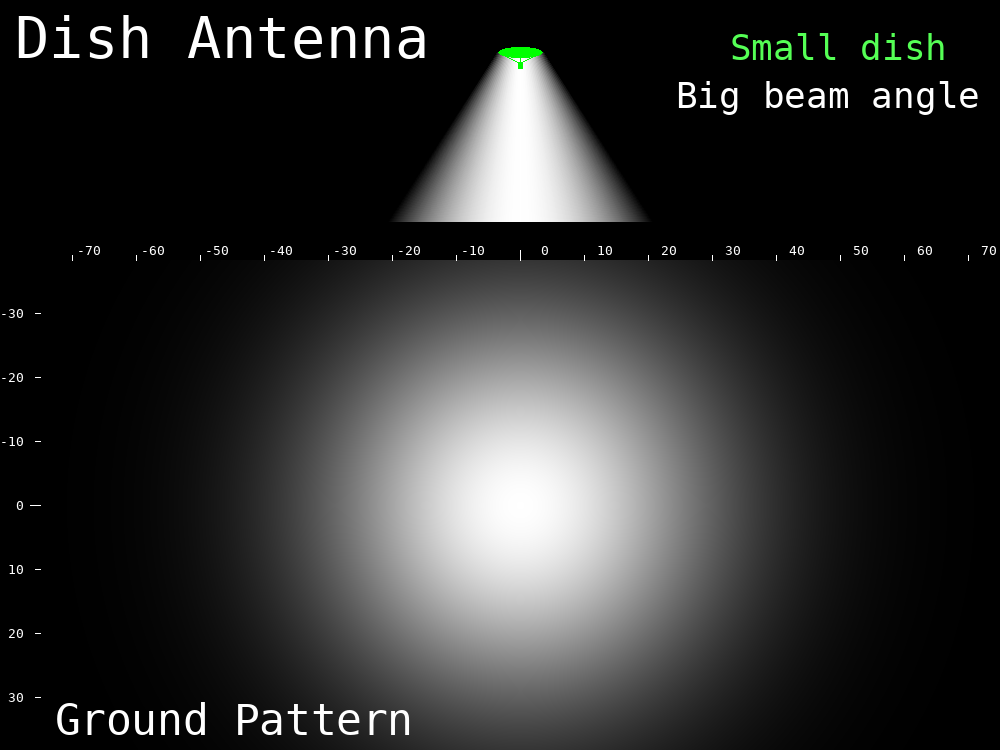
Here is the source. You will need libGD and apngasm.
One Dimensional Phased Arrays and Grating Lobes
More about grating lobes here .
Server Sky thinsat arrays are widely spaced relative to the radio wavelength. However, the spacing in the three dimensional array can be continuously adjusted in 3 dimensions and 3 rotations, subject only to avoidance of radio and solar shading. The arrays move in relation to the target, and rotate around the central orbit, so the phasing changes continuously. However, it changes slowly compared to round-trip ping time.
Three Dimensional Phased Arrays
A naive design for a phased array antenna spaces the elements in a uniform 3 dimensional grid. As a result, the signals from the elements can add constructively in many different directions. The ground pattern from such an array is shown. As the spacing of the elements increases, the size of the focus point decreases, but many grating lobes are introduced, extra focus points that can interfere in other ground locations with the main focus of other nearby arrays pointed intentionally at those other locations. --
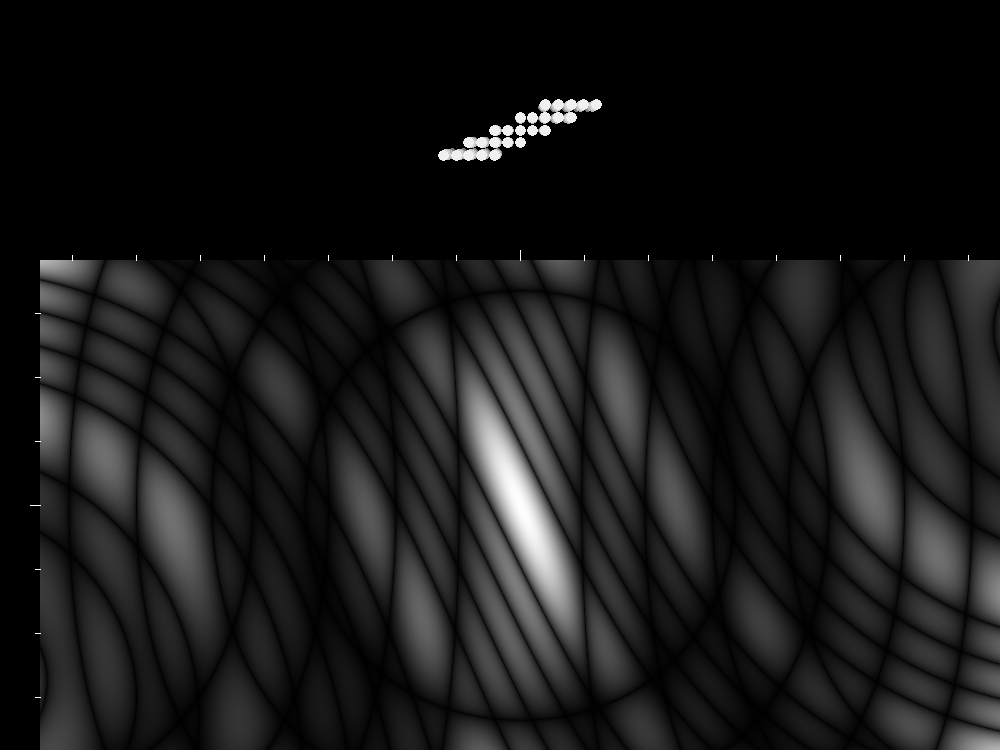
Here is the source. You will need libGD and apngasm.
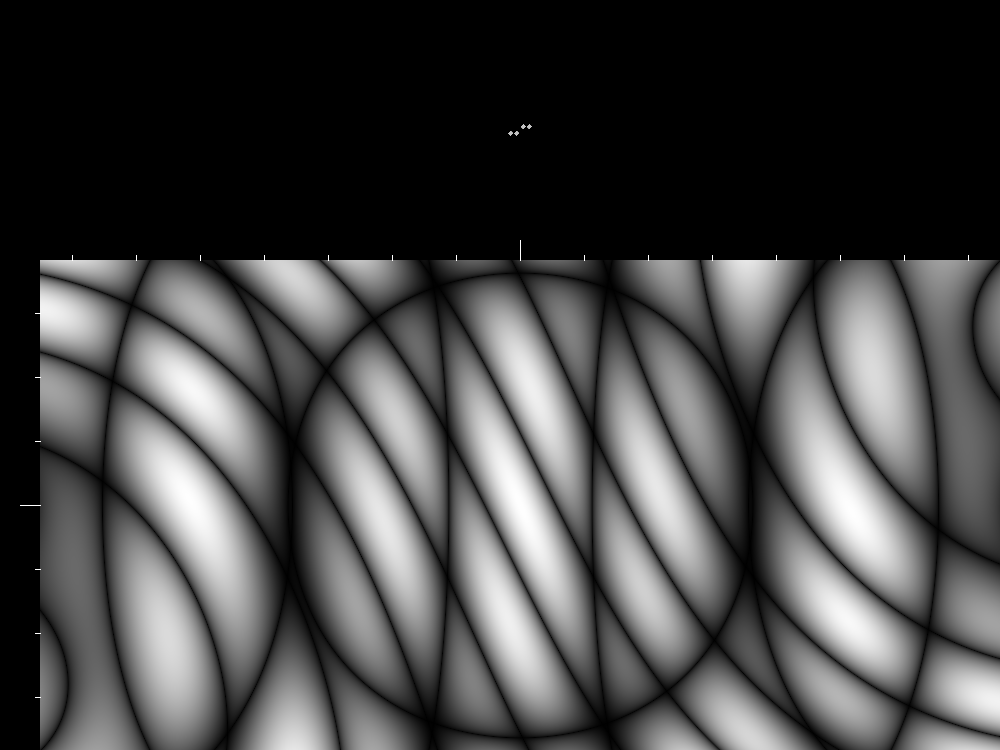
Here is the source. You will need libGD and apngasm.
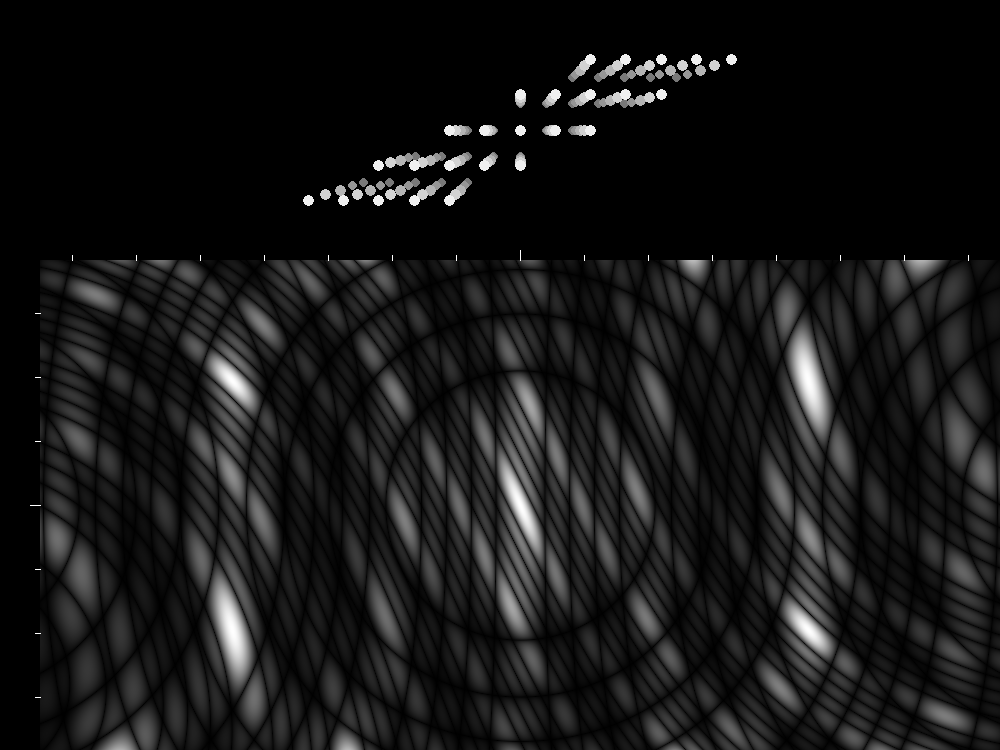
Here is the source. You will need libGD and apngasm
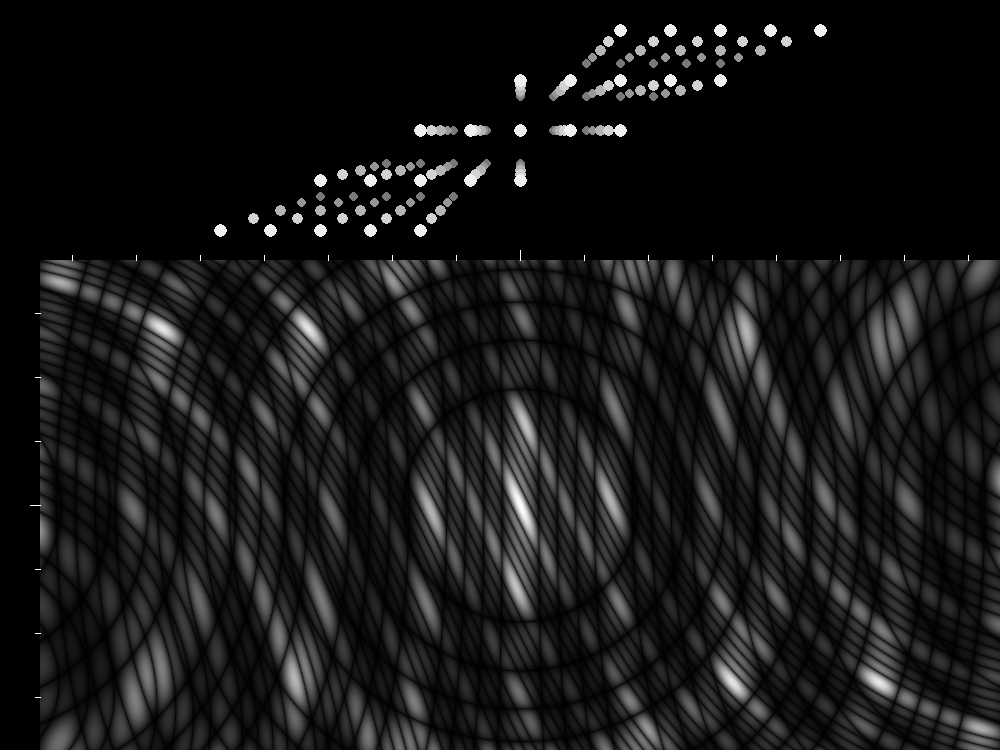
Here is the source. You will need libGD and apngasm.
communication within an array
Thinsat arrays will communicate from satellite to satellite with individual high bandwidth 60GHz beams. All the satellites within an array will need precision timing information, and will also be getting copies of receive and transmit packets for computing phased array beams.
communication between arrays
This will be difficult - not technically, but primarily due to licensing. The server-sky orbits will be approximately in-plane with equatorial communication satellites, which also use in-plane methods to communicate. This means that beams between server-sky arrays will continue beyond the server-sky orbit and up to GEO, causing interference with receivers there.
This can be ameliorated by using very narrow, oblique, and fractional-orbit beams between inclined thinsat arrays, such that the beams are pointed well above or below the orbital plane, and relatively weak when they reach GEO altitudes anyway. Space-to-space communications often use the 60GHz band, where the atmospheric absorption of oxygen is very high, which will isolate the space links from potential jamming on the ground. Here is an example of some oblique beams between arrays:

If the beams must miss the GEO orbit by, say, 5 degrees, and the communication partners are 300km above and below the equatorial plane, then they can be spaced 7000 km apart. This would require 7 hops to travel halfway around the ring (41000km). Actually, they should be spaced closer anyway, to reduce power. The speed-of-light propagation time around the ring is 136ms. If packets are 1400 bits and running 10Gbps, then a packet time is 140nsec. Assume that switching, re-route, queueing and beam forming time add a latency of 5 microseconds to each relay. 1000 hops would add only 5 milliseconds or 4% to the path latency, permitting an array spacing of 41 km, with the arrays only 2km above and below the plane.
As the arrays get denser and larger, the beam size gets smaller, but the amount of inter-array traffic will probably increase faster than the number of communication paths. This needs to be characterized.
Volunteer Opportunity
Study the needed density for cross-orbit links. Keep in mind that many web services will have local caching and proxy service scattered around the ring, to reduce latency and mitigate the 20% downtime caused by earth shadow.
wild speculation: Perhaps someday, when there are billions of thinsats in orbit, server-sky will have physical fiber-optic bundles orbiting around the central orbit to handle this. The circumference of the 12789km m288 orbit is 80000 km; an unshielded 8 micron fiber of that enormous length would weigh 11 kilograms. Of course, there would be many fibers, they would have shielding and cladding and many optical satellites along the length of the system, but at least this demonstrates that optical fiber connecting distant regions of thinsat arrays, while fraught with issues, is not out of the question. For short distances and small populations of thinsats, radios are much easier.
communication with other services
Server-sky as described is confined to near the equatorial plane. This will restrict its usefulness for communications to ground sites with latitudes below 52 degrees or so, which precludes much of northern Europe . While it is possible to add high inclination orbits in synchronization with the main constellation to reach far north, in the short term it is easier to use existing services like Iridium, Globalstar, TDRSS, and the many satellites in GEO to do this. In the near-term, server-sky is primarily doing computation and radar sensing, and the constellations around the equator will be incomplete anyway, so it is better to rely on existing infrastructure when geometries and transponder configuration on the existing satellites permits this. This needs more study.
Volunteer Opportunity
Learn about the communication methods of existing communication satellites, especially for inter-satellite communication. Those transponders and antenna dishes are typically pointed at the ground. What can they listen to?
radar - locating space debris
An important function of a server sky array will be locating space debris and other satellites. Thinsat antennas are too noisy and non-directional to make good radar receivers. However, they make dandy transmitters; working in conjunction with existing radar satellites and ground stations, they can throw very tight beams with high power density through space, and off-angle reflections off small bits of space debris can be detected by many radar receivers optimized for the purpose. This should permit much more accurate location and characterization of much smaller bits of space debris.
orientation to other arrays, GPS, and ground stations
Server sky is blind. It does not have star trackers or ring laser gyros or any other typical orientation device. It may have some MEMs gyros and accelerometers, but those are fragile and expensive to develop and the thinning needed may cost too much for Commercial Off The Shelf (COTS) devices.
Server sky has two senses, though. Sunlight to the solar cell can be measured and used to determine the sun angle. Gratings can be added to sense sun direction. So a thinsat will have some limited optical orientation capability.
Server-sky's main sense is radio. It will be in constant communication with neighboring thinsats, and can do precision orientation and location computations from that. It can also sense signals from ground stations and GPS. Modulated radio and sub-wavelength fringes are used in commercial surveying equipment to measure distances with high precision; server-sky will do the same thing with the 60GHz intra-array communication links. Assuming it can measure phase within 1 degree at 60GHz, a thinsat should be able to locate its many antennas with a 20 micron accuracy. Better measurement capabilities can be added in the future by improving the software.
